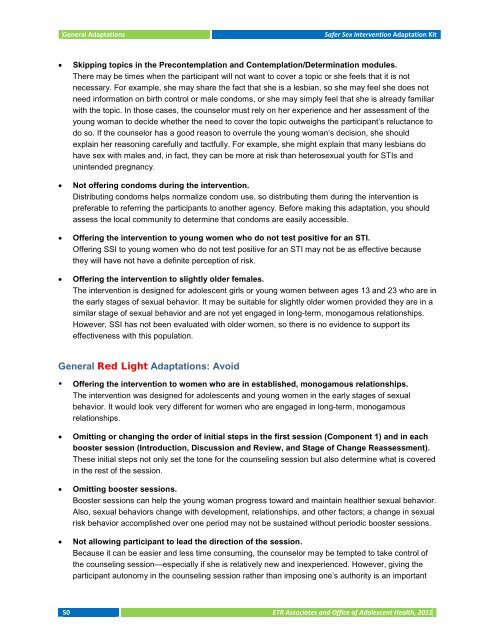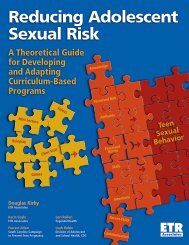Safer Sex Intervention Adaptation Kit - ETR Associates
Safer Sex Intervention Adaptation Kit - ETR Associates
Safer Sex Intervention Adaptation Kit - ETR Associates
You also want an ePaper? Increase the reach of your titles
YUMPU automatically turns print PDFs into web optimized ePapers that Google loves.
General <strong>Adaptation</strong>s<strong>Safer</strong> <strong>Sex</strong> <strong>Intervention</strong> <strong>Adaptation</strong> <strong>Kit</strong>• Skipping topics in the Precontemplation and Contemplation/Determination modules.There may be times when the participant will not want to cover a topic or she feels that it is notnecessary. For example, she may share the fact that she is a lesbian, so she may feel she does notneed information on birth control or male condoms, or she may simply feel that she is already familiarwith the topic. In those cases, the counselor must rely on her experience and her assessment of theyoung woman to decide whether the need to cover the topic outweighs the participant’s reluctance todo so. If the counselor has a good reason to overrule the young woman’s decision, she shouldexplain her reasoning carefully and tactfully. For example, she might explain that many lesbians dohave sex with males and, in fact, they can be more at risk than heterosexual youth for STIs andunintended pregnancy.• Not offering condoms during the intervention.Distributing condoms helps normalize condom use, so distributing them during the intervention ispreferable to referring the participants to another agency. Before making this adaptation, you shouldassess the local community to determine that condoms are easily accessible.• Offering the intervention to young women who do not test positive for an STI.Offering SSI to young women who do not test positive for an STI may not be as effective becausethey will have not have a definite perception of risk.• Offering the intervention to slightly older females.The intervention is designed for adolescent girls or young women between ages 13 and 23 who are inthe early stages of sexual behavior. It may be suitable for slightly older women provided they are in asimilar stage of sexual behavior and are not yet engaged in long-term, monogamous relationships.However, SSI has not been evaluated with older women, so there is no evidence to support itseffectiveness with this population.General Red Light <strong>Adaptation</strong>s: Avoid• Offering the intervention to women who are in established, monogamous relationships.The intervention was designed for adolescents and young women in the early stages of sexualbehavior. It would look very different for women who are engaged in long-term, monogamousrelationships.• Omitting or changing the order of initial steps in the first session (Component 1) and in eachbooster session (Introduction, Discussion and Review, and Stage of Change Reassessment).These initial steps not only set the tone for the counseling session but also determine what is coveredin the rest of the session.• Omitting booster sessions.Booster sessions can help the young woman progress toward and maintain healthier sexual behavior.Also, sexual behaviors change with development, relationships, and other factors; a change in sexualrisk behavior accomplished over one period may not be sustained without periodic booster sessions.• Not allowing participant to lead the direction of the session.Because it can be easier and less time consuming, the counselor may be tempted to take control ofthe counseling session—especially if she is relatively new and inexperienced. However, giving theparticipant autonomy in the counseling session rather than imposing one’s authority is an important50 <strong>ETR</strong> <strong>Associates</strong> and Office of Adolescent Health, 2011
















